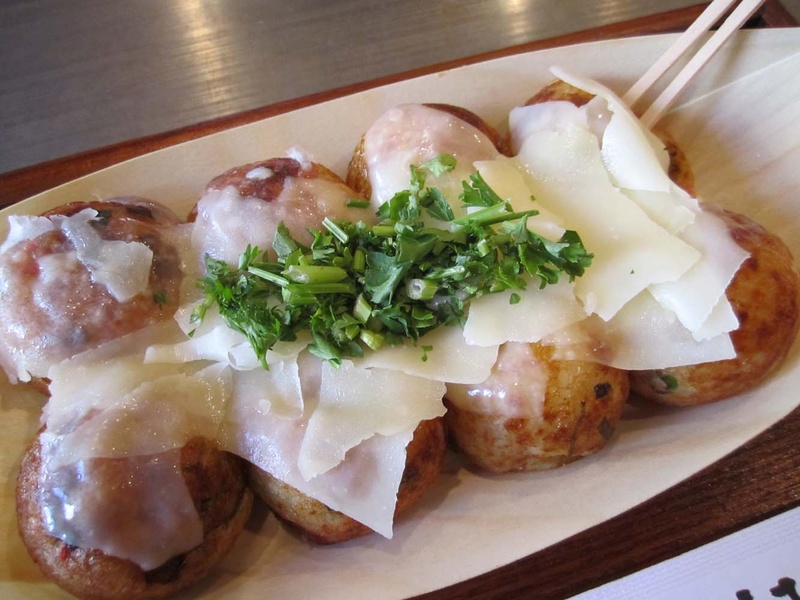Frozen takoyaki production for izakayas and ramen shops
When talking about "home cooking" with people from Kansai, I often hear them say, "We had a takoyaki maker at home since we were kids." As someone from Kyushu, I have the image that takoyaki is not something you eat at home, but something you buy at a food stall. Whether you eat it at home or buy it at a food stall, there is surely no Japanese person who doesn't know about takoyaki. So, how well known is okonomiyaki in the United States? I think okonomiyaki may be more well-known. Both are made from flour, but takoyaki is a snack made by putting octopus, green onions, and tempura scraps in a flour batter and baking it into a round shape. It is eaten with sauce or mayonnaise, but in Hyogo Prefecture there is a unique type called "Akashiyaki" that is eaten by dipping it in a soup with a strong dashi flavor. Personally, I prefer Akashiyaki, which has a milder flavor.
In recent years, when I return to Japan for a short time, I notice a takoyaki chain store. The store, called Gindaco, recently opened a store in the food court of the Japanese food market in Gardena, near Los Angeles, and has expanded into the US. However, this time I will not be writing about this chain store.
Recently, takoyaki has been appearing on the menus of ramen shops and izakayas in Los Angeles as an appetizer or even a dessert. I met the man behind this trend at the Food Expo held in Pasadena in the fall of 2018. His name is Takeo Shibatani. Originally from Osaka, Shibatani currently runs a takoyaki shop called TaNoTa in Little Tokyo, and also runs a business that wholesales frozen takoyaki under the TaNoTa brand to restaurants. There is a high possibility that the takoyaki you unknowingly ate at an izakaya was from TaNoTa. When I asked Shibatani how he got into frozen takoyaki, he replied, "When I was helping out at a ramen shop I knew, I saw that takoyaki was selling well as a side dish, and I felt that there was something going on." He is the type of person who never misses an opportunity and makes sure to make it a reality.
Starting with a food truck and setting up stalls at events
When I heard the name TaNoTa, I remembered a takoyaki shop that operated out of a food truck a few years ago. I have bought from them a few times. They started selling from a food truck in 2010. At the same time, they also focused on selling at booths at events. When they first set up a stall at a Chinese event in the suburbs of Los Angeles, there was apparently an hour-long line. Shibatani recalls, "Most of the customers who lined up were Japanese. We sold out of all 500 servings."
Shibatani was originally a businessman working in the restaurant industry in Japan. With a dream of one day starting a Japanese food business overseas, Shibatani chose Los Angeles as a place to move to, where he could also enjoy his hobby of surfing. He noticed that there were no restaurants serving authentic takoyaki in Los Angeles, and decided to take on the challenge of serving takoyaki, the soul food of his hometown, Osaka.
So, they combined the names of the three Japanese men who were involved in starting the company and came up with the brand name TaNoTa. As mentioned above, they started their business with an affordable food truck. After seeing a positive response from their event booth, Shibatani finally opened a store in March 2018. The store faces the First Street entrance of Japanese Village Plaza, a mall that is crowded with people on weekends. It is right in front of the fire watchtower, the symbol of Little Tokyo. The store is a collaboration with Chinchikurin, an okonomiyaki restaurant from Hiroshima. There is a counter just for TaNoTa, but you can also order and eat takoyaki at Chinchkurin's tables. This means that customers who are attracted to the okonomiyaki and enter the store may have the opportunity to try takoyaki for the first time.
First store in Little Tokyo
The menu at TaNoTa's first store features seven types of takoyaki (original, jalapeno, ponzu, wasabi, mentaiko, sesame, and parmesan truffle), as well as side dishes, three types of shaved ice, beer, and sake. "It's common for people who work around here to drop in in the evening and have a drink with some takoyaki as a snack," says Shibatani. Takoyaki is a rare food that can be enjoyed as both a snack and an appetizer.
The one I had at the restaurant was Parmesan Truffle. It was topped with a generous amount of cheese, which melted from the heat and went perfectly with the takoyaki. It was very filling and very satisfying, and the freshness of something I'd never tasted in Japan was addictive. All the varieties have the same base of takoyaki, with the sauce and toppings adding variety. I'm sure they'll add even more variety to their menu in the future. If jalapeno is Mexican, it wouldn't be surprising if Vietnamese or Indian styles also made an appearance.
Little Tokyo, the Japanese town, used to be quiet. Over 10 years ago, the tonkotsu ramen restaurant Daikokuya opened there, and the town became lively again. Other ramen shops, yakitori shops, conveyor belt sushi shops, udon shops, and Japanese-style yakiniku shops have opened one after another, making it a food paradise where you can enjoy a variety of Japanese cuisines. Takoyaki restaurant TaNoTa has also asserted its presence in this community. We hope that Shibatani's choice of Los Angeles as a place where he can enjoy surfing and start a Japanese food business will be proven correct by the further development of his business in the future.
TaNoTa Takoyaki
350 E. 1st Street,
Los Angeles CA 90012
© 2019 Keiko Fukuda








